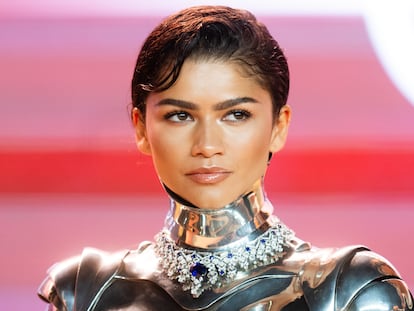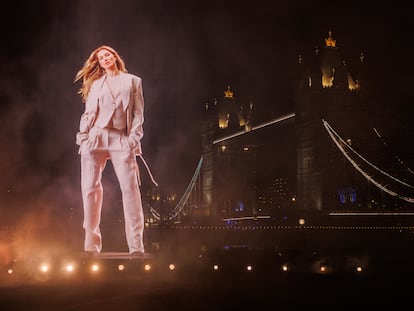The simple act of getting dressed: Milan’s catwalk finds succor in the everyday
Sabato de Sarno’s second collection at Gucci, cave couture at Mari, Ferragamo and Jill Sander’s conceptual protective coats and the sensual imaginings of Dolce & Gabbana: here’s what the second segment of the Italian fashion week brought
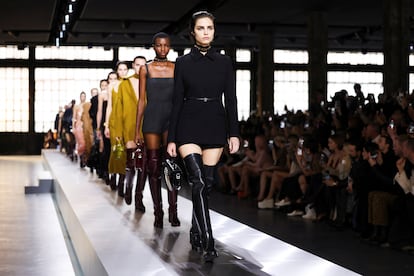
Finding the extraordinary is the ordinary is complicated work, not only requiring effort but also patience and a subtle vision that can be difficult to land in a world ruled by impact and unbridled virality. This is exactly what Sabato de Sarno has decided to do at the helm of Gucci. To take it slow, to build a new image for the century-old Italian brand little by little, a break with its previous maximalism, that at the same time stays in keeping with Gucci’s DNA.
“This is my way of dreaming, without hurry, visualizing and stratifying aspirations as if they were the bricks of a house. Look at the detail very closely, before feeling free to back away in pursuit of a broader perspective. Capture the extraordinary where the ordinary is expected,” reads the statement that accompanied de Sarno’s Friday, February 23 catwalk in Milan, which was the Naples-born designer’s second collection for the Roman fashion house.
De Sarno is in no hurry to get to where he is expected and, even if the impatient demand a finished vision, he seems to be comfortable amid the unfinished, the work in progress. On this occasion, he presented a somewhat more fleshed-out collection than his previous offerings, with appliqués and glitter on coats, which are perhaps the designer’s favorite garments (“making a coat is an act of craftsmanship, a symbol of the culture of technique”), lingerie dresses made of lace, cut and reconstructed in contrast with the rough fabrics of blazers and pea coats in which he blends wools with other more modern fibers. Colors also presented stark contrasts: black, loden green, brown and his Ancora burgundy, the hue created to redefine this new era of Gucci, alternate with pastel tones of yellow, blue and camel.
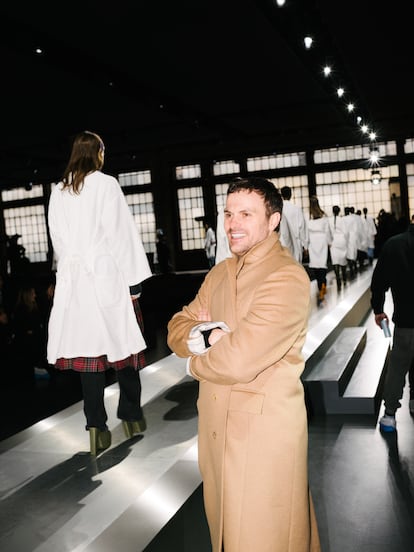
The designer, previously signed by Kering at Valentino, where he was the right hand of Pierpaolo Piccholi, is well-versed in the creation of iconic pieces, a skill that was on display in the new collection. While maintaining a sense of sobriety and patience, he unveiled a new horsebit loafer, an emblematic shoe for the 70-year-old brand, with a towering sky-blue heel: you almost can hear the covetous sighs it occasioned. He put out a warning in an interview with Condé Nast: “I’m not a singer who became a creative director or an actor who became a creative director,” he says. “I was a designer for 20 years. I have touched the clothes, I changed and modified them, I invented them. They have chosen someone who knows how to do this job — if you like it or not, that’s another story — but I surely know how to do this.”
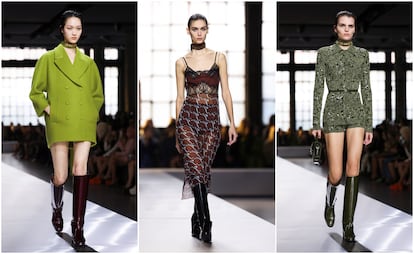
If the first part of this edition of Milan Fashion Week employed subculture influences in using clothing as opposition to a failing system, throughout its second part, designers have focused on the everyday, the very fact and privilege of getting dressed. At the same time, as journalist Vanessa Friedman points out, one is beginning to note a wind change in the predominant aesthetic. Silent luxury has, perhaps, become too silent in a context that demands to be voiced.
At the other end of the spectrum, when it comes to old money’s discreet look, we have the proposal of Francesco Risso at Marni, a brand that has always been the epitome of intellectual, elitist fashion. Only, not anymore. Certainly, not under the command of Renzo Rosso, who is perhaps the most revolutionary owner of a fashion group and was also responsible for Galliano’s rebirth and the most-talked-about haute couture show in recent memory, which the Gibraltar designer presented in Paris. Risso has free rein here to develop his vision: in a white-plastered cave meant to present a clean slate, the designer showed a collection that spoke of rebirth, of beginning from zero. To this end, the looks took the form of what some have dubbed “cave couture.” Snowmen and snowwomen wrapped in furs, leopard print on rigid and primitive dresses in nearly two-dimensional silhouettes. The designer’s team hand-painted the fabrics with oil pigments, gel-coating suits and coats to tease out something new, attractive and conceptually uncomfortable. There is something anti-Platonic about Risso’s cave and his desire to reinvent the outside world free of influences, references and rules. The collection is inspired by a Virginia Woolf phrase: “Please bring no clothes.” The writer penned the phrase in a letter to a friend and fellow member of the Bloomsbury group, T.S. Eliot, upon inviting him to her country home in Sussex. “Please bring no clothes; we live in a state of the greatest simplicity,” she said, making reference to how no previous customs and habits regarding proper dress still applied in 1920s interwar Europe.

It would seem that such a vision is shared by Matthieu Blazy, Bottega Veneta’s new designer. A technique virtuoso who is audacious in his aesthetic, this time around, Blazy downplayed his garments’ trademark complexity. Instead, the focus was on, as he describes it, the “monumentalism of the everyday: a sense of allure and confidence in the pragmatic, the utilitarian and the purpose. In a world on fire, there is something very human in the simple act of getting dressed.” As such, he dispensed with ornamentation, although he did not renounce his now-classic bangs, in leather, wool and chiffon. He shrunk the presence of his intricate knitwear, but did present two pleated ensembles featuring knitted panels between pleats that achieved an optical effect similar to a Julio Le Parc kinetic sculpture. Dresses were, in his words, “extremely pragmatic, the idea that nightwear could be everyday. The technique of coupé and devoré are applied and superimposed on the weave itself to create super-light pieces.” Colors recall a post-apocalyptic world: ash, burnt orange, black, dark brown, grayish green and here and there, red. Wool coats with turned-up seams formed an armor that suggested protection from the times in which we live, another theme that was repeated throughout the Milan collections.
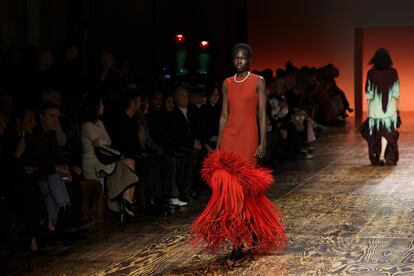
Maximilian Davis, Ferragamo’s young designer, put it like this: “In the 1920s, as a response to the world that surrounded them, people created their own spaces through speakeasies. They were hiding what they were wearing until they were safe.” Such was the inspiration for his collection’s capes, coats and jackets over fluid, transparent dresses made from silk and chiffon, and other more contemporary designs of latex and lacquered organdie. Here, knit and leather became lightweight fabrics, with scale-like leather appliqués finishing off some of the bolder looks, also embellished with feather and sequin finishes. “In the 1920s, they used clothing as a way to celebrate freedom,” states Davis. “That expression of freedom is something which resonates with me, with my heritage, and with Ferragamo.”
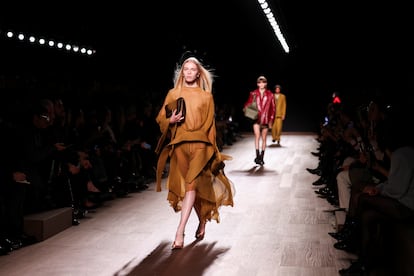
The idea of the protective coat was also rolled out by Lucie and Luke Meier at Jil Sander, not only in terms of the volume of their outerwear’s body-enveloping silhouette, but also in their set, free of corners and edges, a clear continuation of the collection’s concept. Exaggerated organic shapes reminiscent of a sheltering cocoon, or a larva creating its own cavern, were on view. “You can’t ignore the outside world,” said Luke Meier, backstage.
Nonetheless, there are various ways of responding to the tensions of our times. Protecting oneself, restarting, or embracing the extraordinary in the everyday are but a few possible techniques. Other routes could pass through exoticism and distraction, as seen at Dolce & Gabbana. Loyal to their brand’s legacy, the Sicilian designers presented a catwalk that sublimated the use of the smoking jacket with a sensual and hyperfeminine image, one that was happy, lighthearted and provocative. The use of corsetry and lingerie combined with the strength of very formal garments, all in shades of black with varying degrees of transparency, invited one to escape and hold onto joy, a very precious asset indeed.
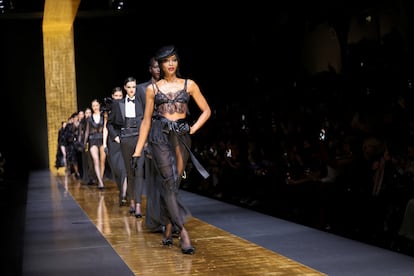
Somewhere between these two poles stood the every-visionary Giorgio Armani, who at 89, seemed to present the most clear-sighted vision at Milan Fashion Week, speaking of optimism. “A message of grace and hope, intertwined with the power and energy of nature and the life cycle of our planet. Flowers that bloom even in the depths of winter, heralding beauty and regrowth,” stated the brand’s notes. Its warm tones, floral blooms, fluidity and models bearing subtle smiles underpinned the idea, notable since, as Virginia Woolf wrote in Orlando, “Vain trifles as they seem, clothes have, they say, more important offices than to merely keep us warm. They change our view of the world and the world’s view of us.” That is no small responsibility.

Sign up for our weekly newsletter to get more English-language news coverage from EL PAÍS USA Edition
Tu suscripción se está usando en otro dispositivo
¿Quieres añadir otro usuario a tu suscripción?
Si continúas leyendo en este dispositivo, no se podrá leer en el otro.
FlechaTu suscripción se está usando en otro dispositivo y solo puedes acceder a EL PAÍS desde un dispositivo a la vez.
Si quieres compartir tu cuenta, cambia tu suscripción a la modalidad Premium, así podrás añadir otro usuario. Cada uno accederá con su propia cuenta de email, lo que os permitirá personalizar vuestra experiencia en EL PAÍS.
¿Tienes una suscripción de empresa? Accede aquí para contratar más cuentas.
En el caso de no saber quién está usando tu cuenta, te recomendamos cambiar tu contraseña aquí.
Si decides continuar compartiendo tu cuenta, este mensaje se mostrará en tu dispositivo y en el de la otra persona que está usando tu cuenta de forma indefinida, afectando a tu experiencia de lectura. Puedes consultar aquí los términos y condiciones de la suscripción digital.
More information
Archived In
Últimas noticias
A survivor’s account of the Interoceanic Train accident: ‘We were scared because of the speed on the curve’
The Interoceanic Train, the Mexican alternative to the Panama Canal
What is known about the Interoceanic Train derailment in Oaxaca
Trump turns a Minnesota fraud allegation into ammunition for his MAGA army against Democrats
Most viewed
- Oona Chaplin: ‘I told James Cameron that I was living in a treehouse and starting a permaculture project with a friend’
- Reinhard Genzel, Nobel laureate in physics: ‘One-minute videos will never give you the truth’
- Why the price of coffee has skyrocketed: from Brazilian plantations to specialty coffee houses
- Pablo Escobar’s hippos: A serious environmental problem, 40 years on
- Chevy Chase, the beloved comedian who was a monster off camera: ‘Not everyone hated him, just the people who’ve worked with him’
